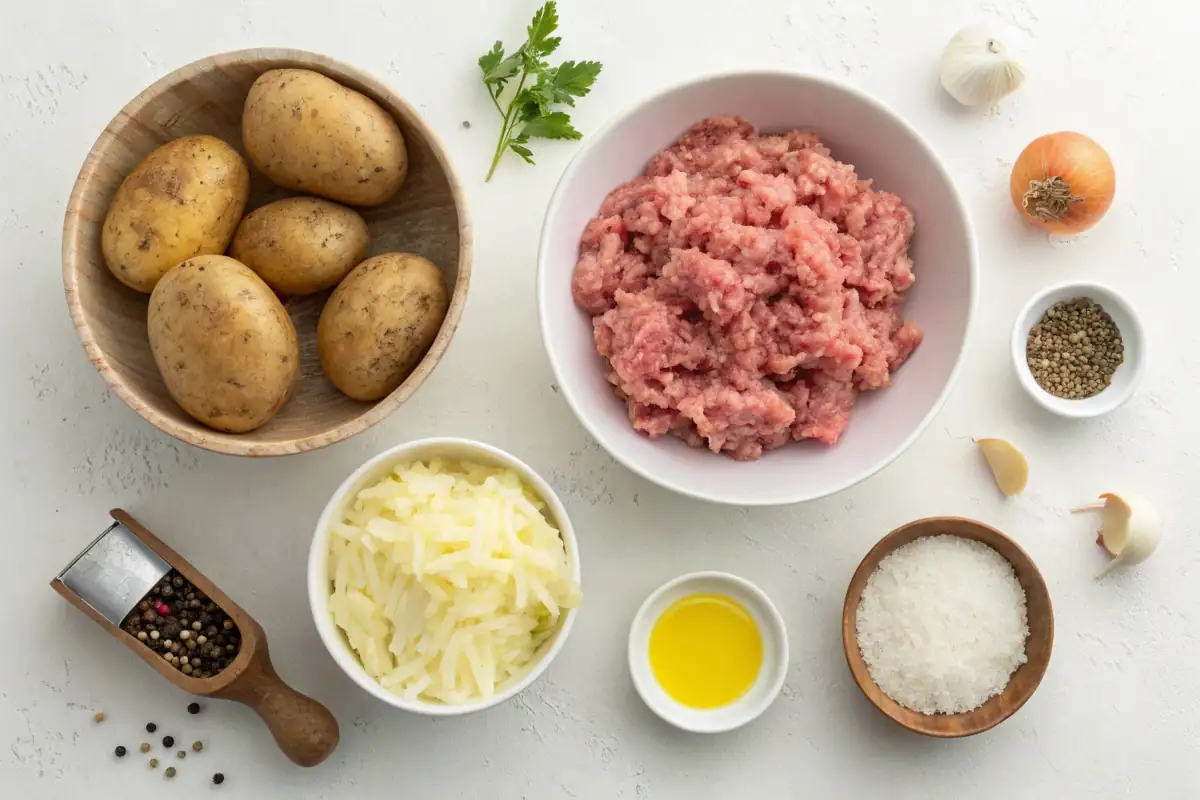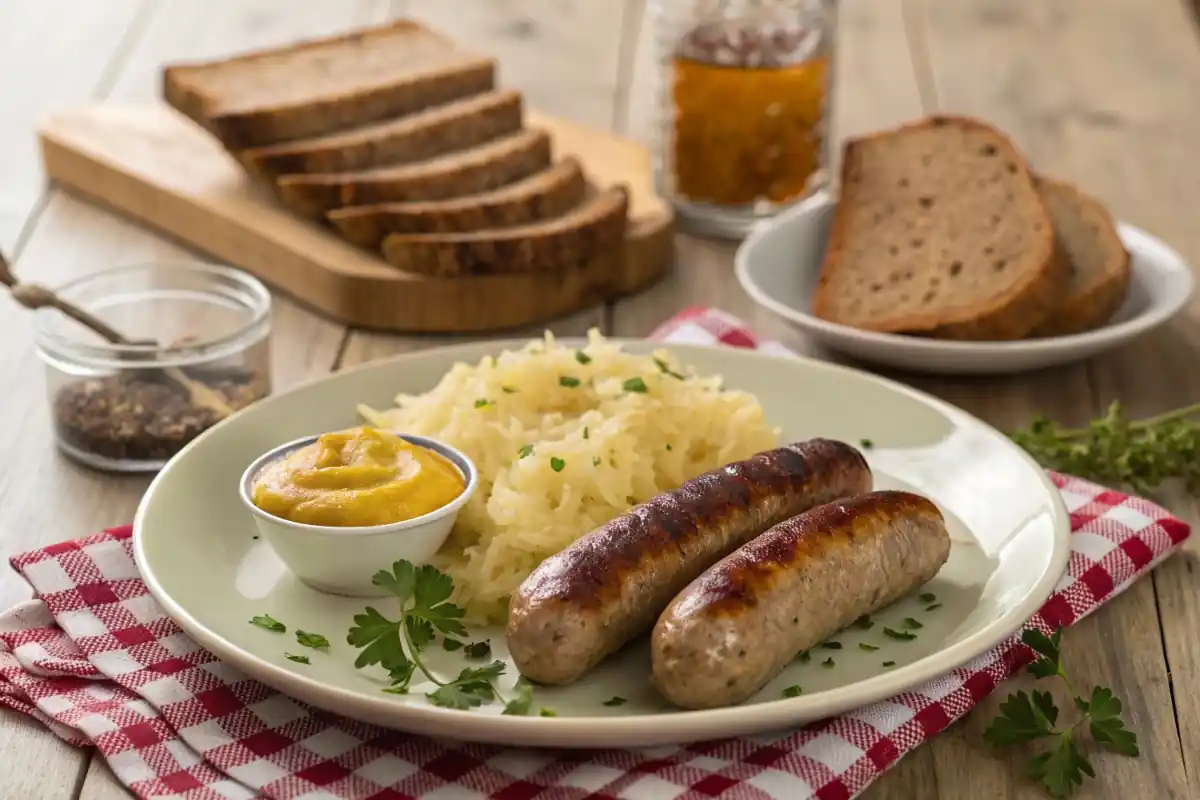Discover the delightful world of potato sausage! This comforting dish is more versatile than you might think.
What is Potato Sausage?
Potato sausage is a type of sausage that combines ground meat with cooked potatoes. It’s a hearty, filling food that’s enjoyed in many cultures. The addition of potatoes gives the sausage a unique texture and flavor.
A Brief History
Sausage making, in general, has a long history. It dates back to ancient times. Preserving meat was essential, and sausage was a great way to do it. Adding potatoes came later, likely as a way to stretch the meat further. Additionally, it provided unique texture and flavor enhancements to the sausage.

Potato Sausage Recipe: Detailed Ingredients and Cooking Instructions
This recipe provides instructions for making potato sausage from scratch. It includes both ingredients and cooking steps that are clear, concise, and easy to follow.
Yields: Approximately 6-8 sausages
Prep time: 1 hour
Cook time: 1-1.5 hours
Ingredients:
- 2 pounds ground pork (preferably a mix of shoulder and belly for flavor)
- 2 pounds potatoes (Russet or Yukon Gold), peeled and cubed
- 1 large onion, finely chopped
- 4 cloves garlic, minced
- 2 tablespoons salt (or to taste)
- 1 tablespoon black pepper (or to taste)
- 1 tablespoon dried marjoram
- 1 teaspoon ground nutmeg
- 1/2 teaspoon ground allspice (optional)
- 1/4 teaspoon cayenne pepper (optional, for a little kick)
- Natural sausage casings (hog casings), approximately 6-8 feet, rinsed thoroughly
- Vegetable oil (for cooking)
Equipment:
- Large pot
- Potato masher or ricer
- Large mixing bowl
- Meat grinder (optional, if grinding your own pork)
- Sausage stuffer (manual or electric)
- Kitchen twine (optional, for linking sausages)
- Meat thermometer

Step-by-Step Cooking Instructions:
- Prepare the Potatoes:
- Place the peeled and cubed potatoes in a large pot.
- Cover with cold water and add a pinch of salt.
- Bring to a boil over high heat, then reduce the heat to medium and simmer for 15-20 minutes, or until the potatoes are fork-tender.
- Drain the potatoes well in a colander. Ensure all the water is out.
- Return the drained potatoes to the pot and mash them thoroughly with a potato masher or ricer until smooth.
- Let the mashed potatoes cool completely. This is very important. Cooling prevents the meat from partially cooking when mixed.
- Sauté the Aromatics:
- While the potatoes are cooking, heat a tablespoon of vegetable oil in a skillet over medium heat.
- Add the finely chopped onion and cook until softened and translucent, about 5-7 minutes.
- Add the minced garlic and cook for another minute until fragrant, being careful not to burn it. Garlic burns easily.
- Remove the skillet from the heat and set aside to cool slightly.
- Prepare the Meat Mixture:
- In a large mixing bowl, combine the ground pork, cooked onion and garlic mixture, salt, pepper, marjoram, nutmeg, allspice (if using), and cayenne pepper (if using).
- Mix all the ingredients together thoroughly with your hands or a spatula until well combined. Even distribution of the seasoning is important.
- Combine Potatoes and Meat:
- Add the cooled mashed potatoes to the meat mixture in the bowl.
- Mix everything together thoroughly until the potatoes are evenly distributed throughout the meat mixture. Be gentle not to overwork.
- Prepare the Sausage Casings:
- Rinse the sausage casings thoroughly under cold running water, both inside and out. This removes excess salt.
- Soak the casings in a bowl of cold water for at least 30 minutes to make them more pliable. Flexibility is key.
- Carefully thread one end of the casing onto the nozzle of your sausage stuffer. Ensure it is snug.
- Stuff the Sausage:
- Load the potato and meat mixture into the sausage stuffer.
- Begin cranking the sausage stuffer to fill the casing with the mixture. Do not overstuff.
- As the casing fills, gently guide it off the nozzle, being careful not to tear it.
- Continue stuffing until all the mixture is used, leaving a few inches of empty casing at the end.
- Link the Sausages (Optional):
- Pinch off the casing at desired intervals (usually 5-6 inches) to form individual sausages.
- Twist each sausage several times in the same direction to seal it.
- Use kitchen twine to tie off the ends of each sausage for extra security, if desired. This prevents bursting.
- Cook the Sausages:
- Pan-Frying:
- Heat a tablespoon of vegetable oil in a large skillet over medium heat.
- Add the sausages to the skillet, being careful not to overcrowd.
- Cook for 15-20 minutes, turning frequently, until the sausages are browned on all sides and cooked through. Ensure the interior is cooked.
- Use a meat thermometer to check the internal temperature, which should reach 145°F (63°C).
- Grilling:
- Preheat your grill to medium heat.
- Place the sausages on the grill grates.
- Grill for 15-20 minutes, turning occasionally, until the sausages are browned on all sides and cooked through. Watch for flare-ups.
- Use a meat thermometer to check the internal temperature, which should reach 145°F (63°C).
- Baking:
- Preheat your oven to 375°F (190°C).
- Place the sausages on a baking sheet lined with parchment paper.
- Bake for 25-30 minutes, turning halfway through, until the sausages are browned and cooked through. Even cooking is best.
- Use a meat thermometer to check the internal temperature, which should reach 145°F (63°C).
- Pan-Frying:
- Rest and Serve:
- Remove the cooked sausages from the heat and let them rest for a few minutes before serving. This retains the juices.
- Serve hot with your favorite sides, such as sauerkraut, mustard, mashed potatoes, or vegetables.
Tips and Notes:
- Spice Variations: Feel free to adjust the seasoning to your liking. Add other spices like paprika, caraway seeds, or dried thyme.
- Meat Variations: You can also use a combination of pork and beef, or even ground turkey or chicken, for a leaner sausage.
- Make Ahead: The sausage mixture can be prepared a day in advance and stored in the refrigerator. This allows the flavors to meld together even more.
- Freezing: Cooked sausages can be frozen for up to 2 months. Wrap them tightly in plastic wrap and then in a freezer bag.
- Sausage Stuffer Alternative: If you don’t have a sausage stuffer, you can use the nozzle attachment of a stand mixer or a pastry bag with a large tip.
- Pricking: Pricking is important when baking or pan frying to ensure even cooking and avoid bursting.
- Linking sizes: Ensure the sausages are roughly the same size for even cooking.

Enjoy your homemade potato sausage!
Advanced Techniques for Home Sausage Makers
For those looking to take their potato sausage-making skills to the next level, consider these advanced techniques:
- Grinding Your Own Meat: Using a meat grinder to grind your own pork allows for greater control over the fat content and texture.
- Natural Casings: Opting for natural hog or sheep casings can enhance the sausage’s snap and overall eating experience. These casings often require careful preparation, including soaking and rinsing to remove excess salt.
- Smoking: Cold-smoking the sausage after stuffing can impart a deep, smoky flavor that compliments the potatoes beautifully. This process requires specialized equipment and careful monitoring of temperature and humidity.
- Fermentation: Some traditional sausage recipes involve a fermentation stage to develop complex flavors and improve preservation. This requires the addition of specific starter cultures and careful control of the environment.
Delicious Ways to Eat Potato Sausage
Potato sausage is incredibly versatile. There are many ways to enjoy it! Its flexibility makes it a staple.
Grilled Potato Sausage with Mustard
Grilling brings out the smoky flavor of the sausage. Serve it with your favorite mustard for a simple, satisfying meal. For instance, a whole grain mustard compliments the smoky flavor.
Pan-Fried Potato Sausage with Onions
Pan-frying gives the sausage a crispy exterior. Cook it with sliced onions for added flavor. The onions should be caramelized for the best taste.
Potato Sausage and Sauerkraut
This is a classic pairing. The tangy sauerkraut compliments the richness of the sausage. Comparatively, it is a common side dish in Eastern European cuisine.
Baked Potato Sausage with Vegetables
Baking is a healthy way to cook sausage. Add your favorite vegetables like peppers and onions for a complete meal. Specifically, root vegetables work well.
Potato Sausage in a Stew
Cut the sausage into pieces and add it to a hearty stew. It adds flavor and substance. Generally, this works best with tomato-based stews.
Potato Sausage with Scrambled Eggs
Dice the sausage and add it to scrambled eggs for a protein-packed breakfast. Add some cheese for extra flavor.
Potato Sausage and Pierogi
This is a classic combination in some cultures. The potato filling in the pierogi compliments the sausage beautifully. It’s especially popular in Polish cuisine.
Potato Sausage Hash
Dice potato sausage and combine it with diced potatoes, onions, and peppers for a hearty hash. Fry it until crispy and serve with a fried egg on top.
Potato Sausage Skewers
Cut potato sausage into chunks and thread them onto skewers with vegetables like bell peppers, onions, and zucchini. Grill or bake until the sausage is cooked through and the vegetables are tender.
Exploring Cultural Variations of Potato Sausage
Potato sausage isn’t limited to one culture. Many countries have their own varieties. These varieties often reflect local tastes.
Lithuanian Potato Sausage (Vedariai)
Lithuanian potato sausage, known as Vedariai, is a beloved traditional dish. It is typically made with grated potatoes, pork, and a variety of seasonings. This sausage is often enjoyed during holidays and special occasions. The ingredients and preparation can vary between families.
Polish Potato Sausage (Kiszka Ziemniaczana)
Polish potato sausage, or kiszka ziemniaczana, is another popular variation. It usually contains a mixture of potatoes, buckwheat groats, and meat. It’s often served grilled or fried.
German Potato Sausage (Kartoffelwurst)
While less common than other variations, some regions of Germany have their own versions of potato sausage, often referred to as Kartoffelwurst. These sausages typically include a mix of cooked potatoes, pork, and seasoning, and are sometimes smoked for added flavor.
Other Regional Twists
You might find potato sausage variations in other Eastern European countries as well. Each region adds its own unique touch. For example, some might add caraway seeds.
Health Benefits of Potato Sausage
While potato sausage can be satisfying, it’s important to consider its nutritional content. Balancing your diet is key.
Protein Content
Sausage, in general, is a good source of protein. Protein is essential for building and repairing tissues. Accordingly, it can be part of a balanced diet.
Carbohydrate Content
The potatoes add carbohydrates to the sausage. Carbohydrates provide energy for your body. Therefore, it is important to consider the carbohydrate content in your diet.
Fat Content
Sausage can be rich in fat. Choose leaner cuts of meat to reduce the fat content. Conversely, some people prefer higher fat content for flavor.
Balancing Your Diet
Enjoy potato sausage as part of a balanced diet. Pair it with vegetables and whole grain options. Additionally, consider portion sizes.
Tips for Buying Potato Sausage
Choosing the right potato sausage can make a big difference. The quality impacts flavor.
Reading Labels
Pay attention to the ingredients list. Look for sausages with minimal additives and preservatives. Undoubtedly, fewer additives are better.
Choosing Quality Meat
Opt for sausage made with high-quality meat from trusted suppliers. Indeed, quality meat is essential.
Considering Fat Content
If you’re conscious of fat intake, choose sausages labeled as “lean.” Explicitly, look for “lean” on the label.
Checking for Freshness
Always check the “use by” date to ensure the sausage is fresh. Smell the sausage before buying; it should have a fresh, clean smell. Avoid sausage that looks slimy or discolored.
Organic and Sustainably Sourced Options
Consider buying organic or sustainably sourced potato sausage to support ethical farming practices and reduce your environmental impact. Look for certifications like “Certified Organic” or “Animal Welfare Approved” on the packaging.
Storing Potato Sausage Properly
Proper storage is key to maintaining freshness and safety. Specifically, refrigeration is important.
Refrigeration
Store uncooked sausage in the refrigerator for only 1-2 days. Cooked sausage can last for 3-4 days. Always store it in an airtight container.
Freezing
Freeze uncooked sausage for up to 2 months. Wrap it tightly to prevent freezer burn. Notably, freezer burn can affect the taste.
Thawing
Thaw frozen sausage in the refrigerator before cooking. Alternatively, you can thaw it in cold water.
Common Mistakes to Avoid
Making or cooking potato sausage can be easy if you avoid these common pitfalls. Chiefly, avoid overcooking.
Overcooking the Potatoes
Potatoes that are cooked for too long will make the sausage mushy. Be sure to drain all excess water after boiling the potatoes.
Using Too Much Seasoning
Start with a small amount of seasoning and adjust to taste. Taste the mixture before stuffing the sausage to ensure it is properly seasoned.
Under-Cooking the Meat
Ensure the meat is cooked to a safe internal temperature. Use a meat thermometer to check the internal temperature. Pork should reach 145°F (63°C).
Not Preparing Casings Properly
Follow instructions carefully when preparing sausage casings. Soaking and rinsing the casings is essential for removing excess salt and ensuring they are pliable.
Overstuffing the Casings
Overstuffing the casings can cause them to burst during cooking. Leave some room for the sausage to expand.
Pricking the Casings
Prick the casings with a needle to release any trapped air and prevent them from bursting during cooking.
Not Allowing the Sausage to Rest
Allow the cooked sausage to rest for a few minutes before serving. This allows the juices to redistribute, resulting in a more flavorful and tender sausage.
Conclusion
Potato sausage is a comforting and versatile food with a rich history. Whether you make it from scratch or buy it from the store, there are countless ways to enjoy it. Explore different variations and pairings to find your favorite way to savor this classic dish. It’s easy and satisfying! Ultimately, the best way to enjoy it is how you like it.
Frequently Asked Questions (FAQs)
How to eat potato sausage?
Potato sausage can be eaten grilled, pan-fried, baked, or added to stews and soups. It pairs well with mustard, sauerkraut, and vegetables.
Where is potato sausage from?
Potato sausage has roots in Eastern European cuisine, particularly in countries like Lithuania and Poland.
What is Lithuanian sausage?
Lithuanian sausage, often called Vedariai, is a type of potato sausage made with grated potatoes, pork, and various seasonings.
Should I boil potatoes before frying?
If you are making potato sausage from scratch, yes, you should boil the potatoes before mixing them with the meat. This ensures that the potatoes are cooked properly and blend well with the other ingredients.

